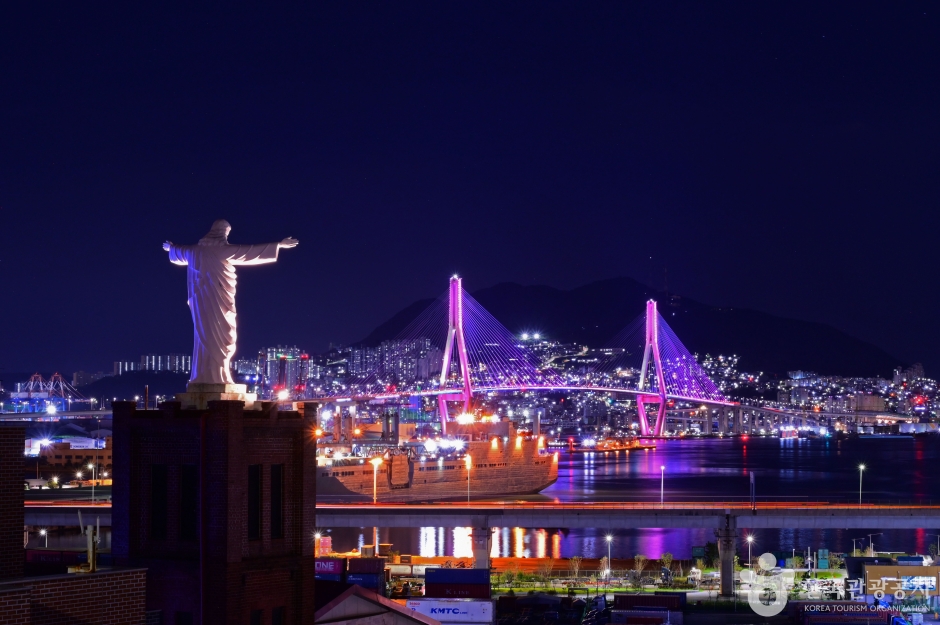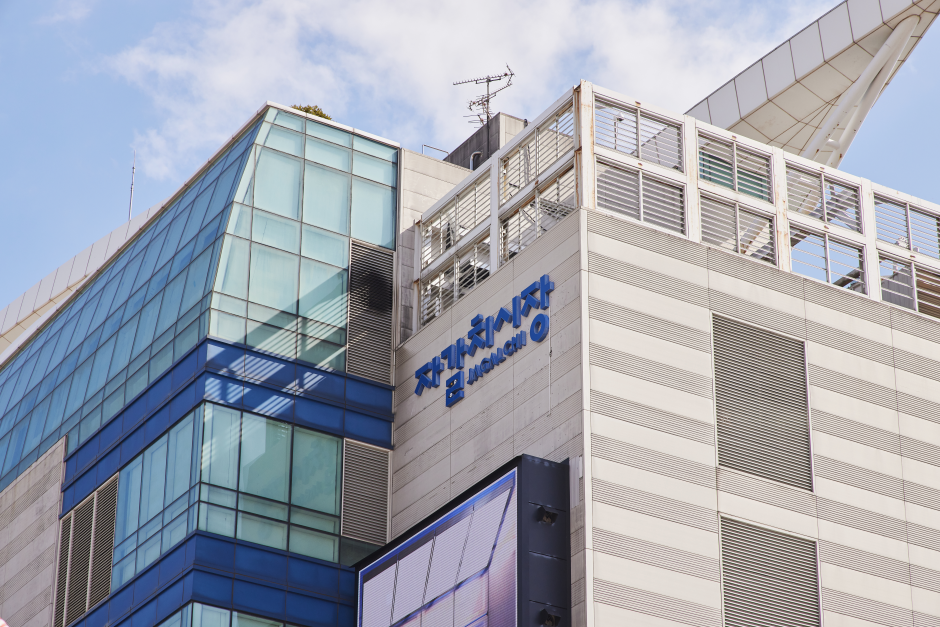Provisional Capital Memorial Hall (임시수도기념관)
2.9Km 2021-04-16
45, Imsisudoginyeom-ro, Seo-gu, Busan
+82-51-231-6345
The Provisional Capital Memorial Hall was established on June 25, 1984. The memorial hall is significant for its role as the provisional government during the Korean War. The memorial hall was built in 1926 and it was used as the residence for the province governor of Gyeongsangnam-do. When the Korean War began in 1950, the building was repurposed to serve as the provisional government of Korea. Currently, the memorial hall is a great place to learn about Korean history because it contains the historical scenes of the provisional government during the Korean War. It contains exhibitions from the Korean War that display the everyday lives of civilians as well as the political, economic, and cultural aspects of the city of Busan.
Hound Hotel Premier Nampo [Korea Quality] (하운드호텔 프리미어 남포 [한국관광 품질인증])
2.9Km 2024-07-01
24 , Bosu-daero, Jung-gu, Busan
+82-51-254-0702
Hound Hotel Premier is a newly built business hotel just 5-minutes’ walk from Jagalchi Station on the Busan Subway. Each room is equipped with high-quality bedding, a sofa, a desk, and a spacious bathtub; some rooms also have an outdoor terrace. There is an elevator and accessible rooms for disabled customers. Cribs can be provided for young children. There is a meeting room which can be hired, and a rooftop with fine views over the city. A concierge, luggage storage and foreign language service is available. The hotel is well positioned for restaurants, sight-seeing and shopping: Jagalchi Market and Bupyeong Kkangtong Market are both nearby.
Busandaegyo Bridge (부산대교)
2.9Km 2024-07-17
41 Namhang-ro 9beon-gil, Yeongdo-gu, Busan
+82-51-600-4000
Built in 1980, Busandaegyo Bridge connects Yeongdo Island to the mainland. It serves as an industrial road that facilitates the transport of freight and cargo from Yeondong-gu District, the center of the shipbuilding industry and an emerging port.
Busandaegyo Bridge is 694 meters long and 20 meters wide, with 16 meters for cars and 2 meters of sidewalk on each side. Compared to other bridges built around the same time, Busandaegyo Bridge has a greater significance in the hearts of the citizens as it was built to commemorate the 100th anniversary of Busan Port and symbolizes the development of the city.
Uam-dong Urban Forest (우암동 도시숲)
2.9Km 2025-04-10
6-6 Donghang-ro 106beonga-gil, Nam-gu, Busan
Uam-dong Urban Forest is famous for its exotic view of the Jesus Christ statue of Donghang Cathedral, which resembles the Christ the Redeemer statue in Rio de Janeiro. It offers a stunning panoramic night view of Busan, spanning the Yeongdo Sea and Busan Harbor Bridge, along with a moon installation photo zone where visitors can take striking silhouette pictures. It is a perfect place to enjoy the beautiful views, snap memorable photos, and relax in the small green forest.
Jagalchi Market Live Fish Section (자갈치시장 활어부)
3.0Km 2018-02-03
52, Jagalchihaean-ro, Jung-gu, Busan
+82-51-245-2594~5
Jagalchi Market was formed by the people who populated the area after the Liberation in 1945, and the Korean War. As one of the largest seafood markets in Asia, the market offers all kinds of seafood to visitors. It is crowded by merchants and visitors every day and a popular attraction among tourists who want to taste fresh seafood. Its Live Fish Section is the most popular section in the market among visitors enjoying fresh sashimi. Visitors can choose live fish to their likings and eat it sashimi-style.
Homeplus - Yeongdo Branch [Tax Refund Shop] (홈플러스 영도)
3.0Km 2024-04-16
57, Daegyo-ro 14beon-gil, Yeongdo-gu, Busan
-
Busan Jungang Market (부산 중앙시장)
3.0Km 2024-02-26
34-3 Jungangbeonyeong-ro 20beon-gil, Busanjin-gu, Busan
Busan Jungang Market, a prominent traditional market in Busan, is noted for its extensive range of flowers, potted plants, and artificial flowers. Beyond its floral offerings, the market also features a diverse array of food options, including tteokbokki, sundae, dakgangjeong (deep-fried and braised chicken), and other deep-fried dishes. Additionally, it offers a variety of attractions and activities. Spanning from the first basement to the third floor, visitors can find restaurants, jewelry stores, and other general shops, along with a wholesale market for flowers and plants.
Nonghyup Hanaro Mart - Jagalchi Branch [Tax Refund Shop] (농협하나로마트 자갈치)
3.0Km 2024-04-22
73, Gudeok-ro, Jung-gu, Busan
-
Yongdusan Jagalchi Special Tourist Zone (용두산 자갈치 관광특구)
3.0Km 2021-03-11
52, Jagalchihaean-ro, Jung-gu, Busan
+82-51-600-4000
Yongdusan Jagalchi Special Tourist Zone is an attractive tourism area embracing history and culture. Vendors in the traditional market welcome tourists with their warm hearts, selling their famous street food such as rice cake, ssiat hotteok (sugar-filled seeded griddlecake), bibim dangmyeon (spicy glass noodles), pat juk (red bean porridge), and pat bingsu (shaved ice with sweetened red beans). Bosu-dong and 40-Step Culture & Tourism Themed Street also show the history of each street to people traveling in the area. Including Yongdusan Park, the special tourist zone includes traditional markets like Jagalchi Market, Gukje Market, and Bupyeong Market, and historical cultural resources like Yeongdodaegyo Bridge, Bosu Book Street, and Busan Modern History Museum. The restoration of Yeongdodaegyo Bridge in November 2013 has created a unique sightseeing attraction that is hard to see in other regions and has emerged as a new famous spot. Bupyeong (Kkongtong) Market and Gukje Market are also special markets full of things to see. Various festivals including Busan International Film Festival, Busan Jagalchi Festival, and Busan Christmas Tree Festival are held for all kinds of visitors. The view from Yongdusan Park and fresh seafood from Jagalchi Market, as well as peaceful strolling at Bosu Book Street and 40-Steps make a trip to Busan memorable and happy.
Current State of Yongdusan and Jagalchi Special Tourist Zone
1) Districts Covered: Areas around Gwangbok, Nampo and Bupyeong-dong, parts of Donggwang, Daecheong, Bosu and Jungang-dong, Busan
2) Total Area: 1,079,836 ㎡
3) Designated on May 14, 2008
* Tourist Attractions
Yongdusan Park, Yeongdodaegyo Bridge, Jagalchi Market, Gukje Market, Bupyeong Market, Bosu Book Street, etc.
Jagalchi Market (부산 자갈치시장)
3.0Km 2025-04-15
52 Jagalchihaean-ro, Jung-gu, Busan
+82-51-245-2594
Jagalchi Market, located on the seaside road in Busan's Jung-gu, is one of the largest seafood markets in Korea, selling both live and dried fish. After the Korean War, the market solidified itself as a fish market. Most of the people who sell fish are women, so the vendors here are called Jagalchi Ajumeoni, "ajumeoni" meaning middle-aged or married woman in Korean.
This market represents Busan and is famous throughout the country. Visitors can eat fresh raw fish right at the market. Even nowadays visitors can see women selling mackerel, sea squirts (ascidians) and other seafood on wooden boxes along the road outside of the market and along the shore.

![Hound Hotel Premier Nampo [Korea Quality] (하운드호텔 프리미어 남포 [한국관광 품질인증])](http://tong.visitkorea.or.kr/cms/resource/67/2651267_image2_1.jpg)


![Homeplus - Yeongdo Branch [Tax Refund Shop] (홈플러스 영도)](http://tong.visitkorea.or.kr/cms/resource/76/2889576_image2_1.jpg)
![Nonghyup Hanaro Mart - Jagalchi Branch [Tax Refund Shop] (농협하나로마트 자갈치)](http://tong.visitkorea.or.kr/cms/resource/90/2888190_image2_1.jpg)

 English
English
 한국어
한국어 日本語
日本語 中文(简体)
中文(简体) Deutsch
Deutsch Français
Français Español
Español Русский
Русский